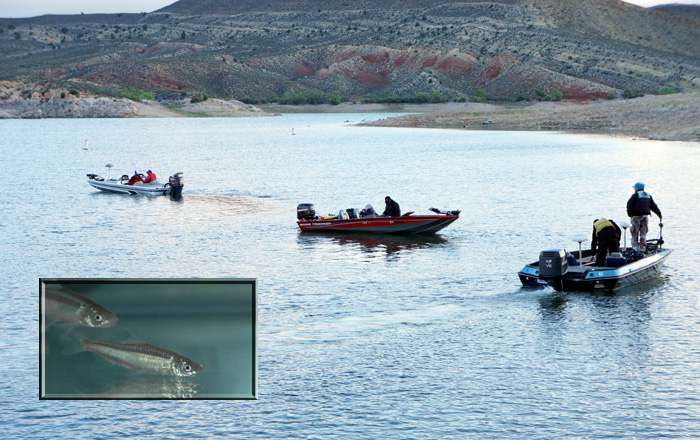
Written by Marcos Camargo
It’s a chilly morning on May 16 at Gunlock Reservoir as about twenty trucks pulling boats stocked with poles, bait, and snacks line up outside the entrance to the boat ramp. It’s tournament day for bass fishing enthusiasts from southwest Utah. Unlike most bass tournaments, this one is more than just about catching the two largest fish of the day. These anglers are also helping the Utah Department of Natural Resources to remove as many bass as possible from the reservoir before the state kills all the fish in Gunlock this coming October with a lethal dose of rotenone.
The purpose of the controlled poisoning is to eliminate smallmouth bass in the lake. Both the Utah Wildlife Division—the part of the DNR that manages Utah’s fisheries—and the U.S. Fish and Wildlife Service list the smallmouth as a prohibited species in the Virgin River system of which Gunlock is a part. Both smallmouth and largemouth bass are non-native species as well as apex predators, meaning they prey on all other fish in the Virgin River, particularly native species. Smallmouth pose the greatest risk to the river system because unlike largemouth, they can live outside the deep waters of the reservoir in the actual river itself.
The Virgin River system supports several species of native fish that are listed as either federally endangered or under conservation watch by the state. Endangered species include the woundfin, Virgin River chub, Southwestern willow flycatcher, and Virgin spinedace. Under state conservation watch are the desert sucker and flannelmouth sucker. It is these fish in particular that the DNR seeks to protect.
The poisoning of the reservoir stirs up discontent in several of the anglers, and it’s the topic of discussion among a group of them as they wait outside their trucks for the gates to open and the tournament to begin. Among the most vocal opponents to using rotenone to eliminate predatory fish are Rob Huston, a professional bass angler with forty years of experience and his fishing partner Matt Baker, a biology student at Dixie State University. Both have passionate views about the way the state is handling the bass issue in the reservoir. They both say the use of poison constitutes “mismanagement” of the fish populations in Gunlock and several other reservoirs in the region.
Using studies conducted by the Upper Colorado River Endangered Species Program, the DNR has concluded that smallmouth can survive and even reproduce in both the Santa Clara and Virgin Rivers. Richard Hepworth, regional aquatic manager for the Division of Wildlife Resources, says that besides the studies, there have also been actual observations of smallmouth living in the river outside of Gunlock.
“At least three have been found in the Santa Clara River… two below the dam and one above,” says Hepworth. “We know that smallmouth bass are very good river fish. There’s a lot of information out there that shows that smallmouth do fairly well in rivers and streams.”
Hepworth says that the Wildlife Division would prefer not to have to use such an extreme measure as dumping rotenone into the reservoir, but at this point it’s the most effective solution in eliminating the risk of a smallmouth population escaping into the Virgin River system. If bass started reproducing in the river, there would be little the DNR could do to stop the problem. Because the state has an agreement with the federal government, an out-of-control bass problem would mean the U.S. Fish and Wildlife Service would step in and put all management under federal purview.
“The Division of Wildlife Resources in the state of Utah signed into an agreement that made smallmouth bass a prohibited species in the Virgin River drainage,” says Hepworth. “This means that we, the Division of Wildlife, cannot stock them in the drainage, and we have to take any measures possible to remove them if they show up in the drainage. The Gunlock situation was a real tough one. We have the agreement we have to get rid of [the smallmouth bass]. The hard part was that Gunlock was just coming back from being drained to be a great fishery.”
Hepworth says that after the rotenone treatment has been shown to be effective, Gunlock will be restocked with largemouth bass, croppy, and either bluegill or redear sunfish. According to Hepworth, the reservoir should bounce back quickly and once again make a great spot for bass anglers.
Huston and Baker, however, don’t agree with the DNR’s assessment.
It’s not so much that either of these anglers can’t live without smallmouth bass in the reservoir. In fact, Gunlock has always been known as a great largemouth fishery. It has only been in the past four years that smallmouth were illegally introduced.
Huston is frustrated over what he sees as a disregard for the anglers. He says that once Gunlock is poisoned, simply reintroducing largemouth back into the reservoir won’t restore it to a great fishery. He would like to see the state build structures that create a habitat for smaller fish that bass eat. Huston says that without these structures and a more diverse infusion of smaller fish and crawdads, the largemouth population will never take off.
“After the lake is restocked, the bass won’t live because there’s no cover,” says Huston. “Without putting structure in [Gunlock], brush and grass and rocks, restocking won’t do any good. The bass won’t live. It’s impossible, period.”
Huston also explains that because the rotenone kills everything with gills, the ecosystem of the lake cannot return to how it is now without more than just placing three types of sport fish in the reservoir.
“You got to have food and habitat… And without that you’re only going to have marginal fish—small fish all the time,” says Huston.
As a professional angler, even a few years without a bass population in Gunlock will potentially cost Huston much of his livelihood.
Other lakes in Utah have gone through the same process planned for Gunlock, and Baker, who actually works with endangered species as part of his studies at DSU, says he believes the DNR isn’t taking enough steps to revive fisheries after treating reservoirs with rotenone. Baker says it’s not only the one time poisoning that upsets him; he also worries about the long term effect of dumping thousands of gallons of piscicides—fish killing agents like rotenone—into lakes across the state. He is also concerned that the state doesn’t do enough to restore lakes after killing and then restocking the fish.
If the poison’s inevitable, which it sounds like it is,” says Baker, “then prior to restocking the lake, there needs to be an emphasis on building structure. Supply the fish with proper habitat, which has proven to be successful in places like Lake Havasu.”
Baker said that the restocking method the DNR uses basically involves “pulling a truck up, dumping in a bunch of fish, and calling it a day.”
“There’s more to it than that,” Baker says. “[The fish] need shelter and food. The restocked bass have no opportunity to maintain their numbers.”
There’s no doubt that controlled poisonings are a complicated issue, but until the people stop illegally placing invasive species into lakes around the state, the DNR will most likely keep rotenone as a tool to manage out of control fish populations.




